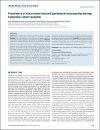Prevalence of vincristine induced-peripheral neuropathy among Sudanese cancer patients
الملخص
Background: Increasing clinical evidence suggests treatment of cancer with neurotoxic agents results in some degree of peripheral neuropathy. Objective: The main objective of the study was to evaluate vincristine induced peripheral neuropathy among Sudanese cancer patients. Methods: A descriptive cross-sectional study was carried out at Radiation and Isotopes Center, Khartoum State, Sudan. All patients suffering from cancer with an age of 18 to 65 years were reviewed. A self-developed data collection form was used to collect the demographic data; drug use history; medical diseases; and vincristine cycles. The World Health Organization criteria were used to grade the side-effects. Data was collected for a period of two months and were analyzed descriptively. Results: Out of 78 patients reviewed, majority were females (n=47, 60.3%). Most of the patients were in the age group of 18-30 (n=27, 34.6%) and 51-60 (n=27, 34.6%) years. Twenty six (33.3%) of the patients took analgesic and 15.3% (n=12) experienced hypertension. Most of the patients went through more than 6 cycles of therapy with vincristine (n=24, 30.9%). Our study showed that 'altered bowel function (i.e constipation)' was the most important neuropathic change, which occurred in 62 (79.5%) of the patients who received vincristine. The second common neuropathic change was the 'lack of ability to go upstairs un-aided', which occurred in 37 (47.4%) of patients receiving vincristine. Majority of the patients (n=37, 47.5%) showed mild paresthesia as graded by the 'WHO grading scale'. Conclusion: More than three-fourth of the cancer patients experienced vincristine induced peripheral neuropathy. Healthcare professionals need some understanding regarding medical management that may decrease occurrence of neuropathy and a better planning and implementing special care for patients at risk.
المجموعات
- أبحاث الصيدلة [1449 items ]


